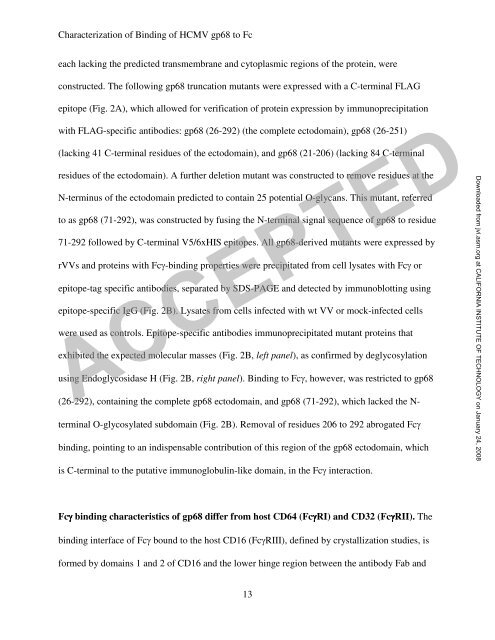The Human Cytomegalovirus Fc Receptor gp68 Binds the Fc CH2 ...
The Human Cytomegalovirus Fc Receptor gp68 Binds the Fc CH2 ...
The Human Cytomegalovirus Fc Receptor gp68 Binds the Fc CH2 ...
You also want an ePaper? Increase the reach of your titles
YUMPU automatically turns print PDFs into web optimized ePapers that Google loves.
Characterization of Binding of HCMV <strong>gp68</strong> to <strong>Fc</strong><br />
each lacking <strong>the</strong> predicted transmembrane and cytoplasmic regions of <strong>the</strong> protein, were<br />
constructed. <strong>The</strong> following <strong>gp68</strong> truncation mutants were expressed with a C-terminal FLAG<br />
epitope (Fig. 2A), which allowed for verification of protein expression by immunoprecipitation<br />
with FLAG-specific antibodies: <strong>gp68</strong> (26-292) (<strong>the</strong> complete ectodomain), <strong>gp68</strong> (26-251)<br />
(lacking 41 C-terminal residues of <strong>the</strong> ectodomain), and <strong>gp68</strong> (21-206) (lacking 84 C-terminal<br />
residues of <strong>the</strong> ectodomain). A fur<strong>the</strong>r deletion mutant was constructed to remove residues at <strong>the</strong><br />
N-terminus of <strong>the</strong> ectodomain predicted to contain 25 potential O-glycans. This mutant, referred<br />
to as <strong>gp68</strong> (71-292), was constructed by fusing <strong>the</strong> N-terminal signal sequence of <strong>gp68</strong> to residue<br />
71-292 followed by C-terminal V5/6xHIS epitopes. All <strong>gp68</strong>-derived mutants were expressed by<br />
rVVs and proteins with <strong>Fc</strong>γ-binding properties were precipitated from cell lysates with <strong>Fc</strong>γ or<br />
epitope-tag specific antibodies, separated by SDS-PAGE and detected by immunoblotting using<br />
epitope-specific IgG (Fig. 2B). Lysates from cells infected with wt VV or mock-infected cells<br />
were used as controls. Epitope-specific antibodies immunoprecipitated mutant proteins that<br />
ACCEPTED<br />
exhibited <strong>the</strong> expected molecular masses (Fig. 2B, left panel), as confirmed by deglycosylation<br />
using Endoglycosidase H (Fig. 2B, right panel). Binding to <strong>Fc</strong>γ, however, was restricted to <strong>gp68</strong><br />
(26-292), containing <strong>the</strong> complete <strong>gp68</strong> ectodomain, and <strong>gp68</strong> (71-292), which lacked <strong>the</strong> N-<br />
terminal O-glycosylated subdomain (Fig. 2B). Removal of residues 206 to 292 abrogated <strong>Fc</strong>γ<br />
binding, pointing to an indispensable contribution of this region of <strong>the</strong> <strong>gp68</strong> ectodomain, which<br />
is C-terminal to <strong>the</strong> putative immunoglobulin-like domain, in <strong>the</strong> <strong>Fc</strong>γ interaction.<br />
Downloaded from jvi.asm.org at CALIFORNIA INSTITUTE OF TECHNOLOGY on January 24, 2008<br />
<strong>Fc</strong>γ binding characteristics of <strong>gp68</strong> differ from host CD64 (<strong>Fc</strong>γRI) and CD32 (<strong>Fc</strong>γRII). <strong>The</strong><br />
binding interface of <strong>Fc</strong>γ bound to <strong>the</strong> host CD16 (<strong>Fc</strong>γRIII), defined by crystallization studies, is<br />
formed by domains 1 and 2 of CD16 and <strong>the</strong> lower hinge region between <strong>the</strong> antibody Fab and<br />
13
















